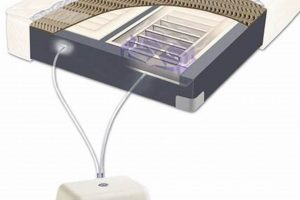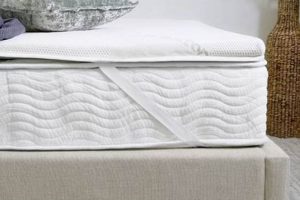The cushioning component designed specifically to fit within the frame of a convertible couch, offering a sleeping surface when the unit is unfolded. These components vary significantly in construction, materials, and intended usage scenarios. As an example, a tri-fold mechanism requires a segmented option, while a platform design can often accommodate a single, continuous piece.
The selection of an appropriate sleeping surface profoundly impacts the comfort and usability of convertible furniture. Historically, these products were often viewed as temporary solutions; however, advancements in materials science and manufacturing processes have led to increased availability of models designed for frequent or even daily usage. The comfort level affects guest satisfaction and the overall practicality of a dual-purpose furnishing.
Understanding the nuances of size, composition, and construction is crucial when assessing potential options. The following sections will delve into the key considerations for choosing the proper cushioning element, including thickness, material types, and compatibility with various convertible couch mechanisms, to optimize comfort and longevity.
Selection Guidance
Optimizing the comfort and lifespan of convertible furniture necessitates careful consideration of several key factors during selection of its primary cushioning component. The following guidance addresses critical aspects to ensure informed decision-making.
Tip 1: Measure the Internal Frame Dimensions. Accurate measurements of the folded-out bed frame are paramount. Discrepancies can lead to improper fit, causing discomfort or mechanical issues. Account for any hinges or obstructions within the frame.
Tip 2: Evaluate Material Density and Composition. Higher-density foam or the inclusion of inner springs generally indicates enhanced support and durability. Investigate the specific composition (e.g., memory foam, latex, innerspring) and its suitability for the intended use frequency.
Tip 3: Assess Thickness Requirements. The depth of the frame often dictates the maximum acceptable thickness. Exceeding this limit can hinder the folding mechanism or create an uneven sleeping surface. A thinner, high-density option may be preferable to a thicker, low-density one.
Tip 4: Consider Weight Limitations. The support system within the frame has a defined weight capacity. Selecting a model exceeding this limit can cause structural damage or reduce the lifespan of the convertible couch.
Tip 5: Prioritize Breathability. Materials that promote airflow, such as open-cell foam or those with integrated ventilation channels, can mitigate heat buildup and improve sleep quality. This is particularly important for frequent usage.
Tip 6: Investigate Warranty and Return Policies. Before finalizing a purchase, carefully review the manufacturer’s warranty and return policy. This provides recourse in the event of manufacturing defects or dissatisfaction with the comfort level.
Tip 7: Evaluate Edge Support. Reinforced edges prevent sagging and provide a more stable sleeping surface, particularly for those who tend to sleep near the edge of the bed. This enhances overall comfort and longevity.
Adherence to these guidelines maximizes the likelihood of selecting a component that provides adequate support, durability, and comfort, ensuring the long-term usability and satisfaction with the convertible furnishing.
The following section explores specific material types and their associated benefits and drawbacks, further aiding in the decision-making process.
1. Dimensions
Dimensional accuracy is a paramount consideration in the selection of a cushioning element for a convertible couch, exerting a direct influence on both functionality and user comfort. Improper dimensions can impede the folding mechanism, rendering the sofa unusable in either its seating or sleeping configuration. For instance, a width that exceeds the frame’s internal clearance will prevent complete closure, while insufficient length leaves gaps that compromise support and safety.
The effects of inaccurate measurements manifest in various ways. A thickness exceeding the frame’s capacity can place undue stress on hinges and support structures, potentially leading to premature failure. Conversely, an undersized option may shift during use, creating an uneven and uncomfortable sleeping surface. A real-world example involves a tri-fold mechanism, where segmented cushions must align precisely; even slight discrepancies can result in pressure points and reduced lumbar support. Furthermore, the height dimension directly impacts the overall bed height when deployed, influencing accessibility and comfort for individuals with mobility limitations.
In summary, precise dimensional measurement and adherence to manufacturer specifications are critical to ensure proper function and optimal comfort. The challenges arising from dimensional inaccuracies range from mechanical malfunction to compromised sleep quality, highlighting the practical significance of thorough and precise evaluation prior to purchase. The subsequent discussion will address the material composition and its role in determining comfort and durability.
2. Material Composition
Material composition critically influences the performance, longevity, and comfort of a cushioning component designed for a convertible couch. The internal makeup dictates factors such as support, breathability, motion isolation, and resistance to wear and tear, directly affecting user satisfaction and the overall lifespan of the furnishing.
- Foam Density and Type
Foam density, measured in pounds per cubic foot, determines the support and durability. High-density foams offer superior support and resistance to compression over time, while low-density options are more prone to sagging and deformation. Common types include polyurethane, memory foam (viscoelastic), and latex, each possessing distinct properties. For example, memory foam conforms to the body, providing pressure relief but potentially trapping heat, whereas latex offers resilience and breathability. The choice of foam impacts the overall feel and suitability for different sleeping preferences.
- Innerspring Construction
Innerspring construction incorporates coils that provide support and contribute to airflow. Coil count, gauge (thickness), and arrangement influence the firmness and contouring ability. Pocketed coils, where each spring is encased in fabric, minimize motion transfer, reducing disturbances for co-sleepers. Conversely, interconnected coil systems offer more uniform support but may transmit movement more readily. The integration of innersprings contributes to the overall structural integrity and support characteristics.
- Fiber Fill and Ticking
Fiber fill, such as polyester or cotton batting, provides a cushioning layer between the support core (foam or innerspring) and the outer ticking (fabric covering). The type and quantity of fiber fill affect the surface feel and comfort. Ticking materials range from basic cotton to specialized fabrics with enhanced breathability, moisture-wicking properties, or antimicrobial treatments. The combination of fiber fill and ticking influences the overall comfort and hygienic properties of the sleeping surface.
- Flame Retardant Materials
Regulations mandate the inclusion of flame retardant materials to enhance safety and reduce fire hazards. These materials can be integrated into the foam, fiber fill, or ticking. However, some flame retardants have raised health concerns, prompting a shift towards alternative, less-toxic options. The selection of flame retardant materials balances safety requirements with potential health and environmental impacts.
The interplay between these components defines the characteristics of a cushioning element intended for convertible couches. The combination impacts not only comfort and support but also durability, breathability, and safety. A careful evaluation of the constituent materials is essential to optimize performance and longevity. For example, a high-density memory foam core with a breathable ticking and pocketed coils can offer a balance of comfort, support, and motion isolation suitable for frequent use.
3. Thickness Limitations
Thickness limitations constitute a critical design constraint in the selection of a suitable cushioning element for convertible couches. The internal mechanics of these furnishings, specifically the folding and unfolding mechanisms, impose strict dimensional requirements that dictate the maximum permissible depth. Exceeding these limits can compromise functionality and structural integrity.
- Mechanism Compatibility
The type of folding mechanism employed directly correlates with allowable depth. Tri-fold designs, characterized by multiple hinged sections, typically accommodate thinner options compared to platform-style mechanisms. Attempting to use an excessively thick option with a tri-fold system can obstruct the folding process, causing undue stress on the hinges and potentially leading to mechanical failure. In contrast, platform designs often offer greater flexibility regarding depth but are still subject to limitations based on the overall frame dimensions. A real-world example includes a scenario where a 6-inch option renders a tri-fold sofa bed inoperable, while a 4-inch model functions flawlessly.
- Frame Clearance
The internal dimensions of the frame establish the physical boundaries within which the cushioning element must reside, both in the folded and unfolded states. Insufficient clearance can result in compression of the materials, leading to reduced comfort and accelerated wear. Furthermore, it can impede the proper latching and securing of the folded unit, posing safety hazards. For example, if a frame is designed for a maximum depth of 5 inches, exceeding this limit will result in a bulging or uneven surface when the sofa is closed, potentially damaging the upholstery and the folding mechanism. Precise measurement of the internal frame dimensions is therefore essential.
- Weight Distribution and Support
While depth contributes to overall support, exceeding the recommended thickness can negatively impact weight distribution and stability. An excessively thick option may concentrate weight in certain areas, leading to uneven wear and potential frame damage. Conversely, a thinner, high-density option can provide adequate support without compromising the mechanical integrity of the folding mechanism. The relationship between depth, density, and support must be carefully considered to ensure both comfort and structural soundness. For instance, a thin, high-density foam offers better weight distribution compared to a thick, low-density option, particularly in the context of convertible couch usage.
- Aesthetics and Upholstery
The thickness of the sleeping surface influences the overall aesthetic appeal of the convertible couch, both in its sofa and bed configurations. An excessively thick option may protrude beyond the frame, creating an ungainly appearance and potentially interfering with the upholstery. Conversely, an option that is too thin may appear inadequate and detract from the perceived value of the furniture. Balancing thickness with aesthetic considerations is crucial to achieve a visually pleasing and functional design. A well-proportioned sleeping surface seamlessly integrates with the overall design of the convertible couch, enhancing its aesthetic appeal and usability.
These considerations highlight the critical role that thickness limitations play in determining the suitability of a cushioning element. Understanding the interplay between mechanism compatibility, frame clearance, weight distribution, and aesthetics is essential to select an option that maximizes both comfort and functionality without compromising the structural integrity or aesthetic appeal of the convertible couch. The subsequent discussion will address the various types of materials commonly employed in their construction and their suitability for specific applications.
4. Support Structure
The support structure is integral to the functionality and longevity of any cushioning designed for a convertible couch. It dictates weight distribution, prevents sagging, and contributes significantly to overall comfort. Without adequate support, even the highest-quality cushioning materials will quickly degrade, resulting in an uneven sleeping surface and a reduced lifespan for the furniture. The relationship between the cushioning and its underlying support system is symbiotic; one cannot function optimally without the other. The presence of a robust support system ensures that weight is distributed evenly across the surface, mitigating pressure points and preventing localized compression, which is a common cause of discomfort and premature wear.
Diverse support structures exist, each offering unique characteristics. These include innerspring systems, foam bases of varying densities, and interconnected webbing or wire grids. Innerspring systems, for instance, rely on the compression and rebound of individual coils to provide support. The gauge and coil count influence firmness and weight capacity. Conversely, foam bases offer a continuous, uniform surface that distributes weight evenly, though their long-term durability is dependent on the foam’s density and resistance to compression set. Webbing or wire grids, often found in older or more economical designs, provide a basic level of support but are prone to sagging over time, especially under heavier loads. Selecting a compatible support structure to match the cushioning material is key. Memory foam, for example, benefits from a solid, stable foundation to prevent excessive sinking, while latex may perform optimally with a more flexible innerspring system that allows for greater contouring. The absence of adequate support leads to noticeable sagging, particularly in areas of high use or concentrated weight. Such degradation not only diminishes comfort but also accelerates wear on the cushioning materials.
In summary, the support structure is a foundational component of any cushioning designed for convertible couches. Its presence and integrity directly impact weight distribution, comfort, and long-term durability. The selection of an appropriate support system, matched to the cushioning material and anticipated usage patterns, is a crucial consideration in ensuring both functionality and user satisfaction. Compromising on support structure invariably leads to diminished comfort, accelerated wear, and a reduced lifespan for the convertible furnishing. The subsequent section will address foldability for these models and its realted challenges.
5. Foldability
The characteristic of a cushioning component designed for convertible couches to compress and conform to the folded configuration of the underlying mechanism represents foldability. This attribute directly dictates the ease and efficiency with which the furniture transitions between seating and sleeping modes. Improper foldability compromises the intended dual functionality, potentially causing mechanical stress and reducing the overall lifespan of the unit. A non-foldable or poorly foldable sleeping surface necessitates undue force to close the sofa, potentially damaging the frame, hinges, and upholstery. Consider a scenario where a memory foam unit with excessive density resists compression; attempting to close the sofa may damage the folding mechanism or prevent complete closure. The inherent relationship between these two features underscores the criticality of design that accounts for both comfort and practical usability.
The integration of segmented construction or the utilization of materials with inherent flexibility constitutes a key design approach to achieving appropriate foldability. Segmented designs, common in tri-fold mechanisms, allow for independent articulation of each section, minimizing stress on the folding joints. Materials such as low-density foam or those with strategically placed flex points enable compression without permanent deformation. For instance, a hybrid design incorporating a thin layer of high-density foam over a base of flexible support webbing achieves a balance between comfort and foldability. The practical application of these design principles extends to the selection of materials with a suitable compression set, meaning the material returns to its original shape after being compressed. Materials with a high compression set retain a significant portion of their compressed shape, hindering the folding process and reducing long-term comfort.
In conclusion, foldability is an indispensable attribute for the design of a practical and durable component for convertible couches. Its presence ensures effortless transitions between seating and sleeping modes, minimizing mechanical stress and extending the lifespan of the furniture. Design approaches centered on segmented construction and the selection of flexible materials with low compression sets are essential to achieving optimal foldability. Neglecting this crucial aspect compromises the intended functionality and ultimately diminishes the user experience and the longevity of the furniture piece.
Frequently Asked Questions
The following addresses common inquiries regarding cushioning components designed for convertible couches, providing concise, informative answers to aid in informed decision-making.
Question 1: What distinguishes a “mattress for sleeper sofa” from a standard mattress?
The primary distinction lies in dimensional constraints and foldability requirements. A standard mattress is not designed to withstand repeated folding and unfolding, nor is it typically sized to fit within the confines of a convertible couch frame. “Mattress for sleeper sofa” products are specifically engineered to accommodate these limitations.
Question 2: How does the material composition of a “mattress for sleeper sofa” affect its lifespan?
Material composition significantly impacts durability. High-density foams and innerspring constructions generally offer superior resistance to compression and wear compared to low-density alternatives. The selection of appropriate materials is crucial to ensure long-term performance and prevent premature sagging or deformation.
Question 3: What role does thickness play in the selection of a “mattress for sleeper sofa?”
Thickness is a critical factor, governed by the mechanism of the convertible couch. Exceeding the maximum allowable thickness can impede the folding process and potentially damage the frame. Conversely, insufficient thickness may compromise support and comfort. Matching the thickness to the mechanism’s specifications is essential.
Question 4: Are “mattress for sleeper sofa” products available in various firmness levels?
Yes, a range of firmness levels is generally available, catering to diverse sleeping preferences. Options range from plush, conforming surfaces to firm, supportive designs. Considering individual needs and sleeping habits is essential to selecting an appropriate firmness level.
Question 5: How does one properly clean and maintain a “mattress for sleeper sofa?”
Cleaning and maintenance protocols depend on the materials used. Regular vacuuming is recommended to remove dust and debris. Spot cleaning with a mild detergent may be necessary for stains. Following the manufacturer’s instructions for specific cleaning agents and techniques is crucial to avoid damaging the materials.
Question 6: Is it possible to replace the “mattress for sleeper sofa” in an existing convertible couch?
Yes, replacement is generally feasible, provided that the dimensions and thickness of the replacement align with the original specifications. Measuring the frame and understanding the mechanism’s limitations is essential to ensure proper fit and functionality.
Proper selection, care, and maintenance of components for convertible couches contribute significantly to long-term comfort, functionality, and value. Adhering to manufacturer guidelines and considering individual needs are paramount.
The following section will present a concluding summary, consolidating key considerations for informed decision-making.
Concluding Remarks on Mattress for Sleeper Sofa Selection
This examination of the “mattress for sleeper sofa” has underscored the crucial interplay between dimensions, material composition, support structure, and foldability in achieving both comfort and functionality. Selecting the appropriate cushioning element involves a careful evaluation of these factors, aligning with the specific limitations and capabilities of the convertible couch mechanism. Compromising on any of these aspects can lead to diminished user satisfaction and premature degradation of the furniture.
The long-term utility and value of a convertible couch depend significantly on the suitability of its integrated sleeping surface. Investing time in understanding the nuances of available options and adhering to established guidelines for selection and maintenance represents a worthwhile endeavor. This approach ensures the ongoing functionality and comfort of this adaptable furniture piece, maximizing its potential for diverse applications.


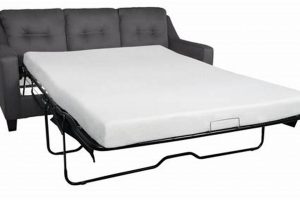
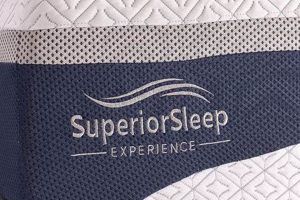
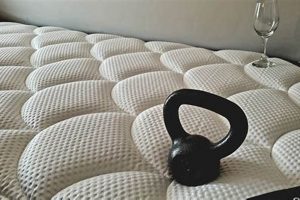
![Best Sleep Number Camper Mattress [Guide] For RV Organic & Natural Mattress Buyer’s Guide: Non-Toxic Sleep Solutions Best Sleep Number Camper Mattress [Guide] For RV | Organic & Natural Mattress Buyer’s Guide: Non-Toxic Sleep Solutions](https://mattressworldpa.com/wp-content/uploads/2025/07/th-1764-300x200.jpg)
